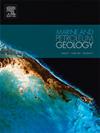New method for logging identification of natural fractures in shale reservoirs: The Fengcheng formation of the Mahu Sag, China
IF 3.7
2区 地球科学
Q1 GEOSCIENCES, MULTIDISCIPLINARY
引用次数: 0
Abstract
Natural fractures are one of the critical types of reservoir space in lacustrine shale formations. The enrichment, preservation, and production of shale oil are closely related to these natural fractures. However, the development of various sedimentary structures in lacustrine shale can interfere with fracture identification. In this study, we combined image logging and array sonic logging methods to examine the response characteristics of natural fracture development zones in the borehole, near-wellbore, and far-wellbore regions. We integrated a new logging identification method for natural fractures and explored the relationships among mineral composition, fracture types, and reservoir quality, providing a reference for selecting sweet spots in lacustrine shale reservoirs. Core samples, thin sections, and scanning electron microscope observations of the Fengcheng Formation shale reveal characteristics of multi-scale natural fracture development. High-angle and oblique fractures, which are relatively easy to identify, were recognized using core-calibrated image logs and appear as sinusoidal features on image logs. Low-angle fractures, however, require correlation with core observations for accurate identification. Using array acoustic logging data, including shear leaky and reflected waves, we obtained radial profiles of fast and slow shear waves based on dispersion variations, enabling the determination of fracture development zones. The crossing of slowness curves of fast and slow shear waves along the radial direction and strong responses of red energy clusters in radial profiles indicate the presence of fractures. Additionally, processing of shear-wave reflected wave information remote acoustic reflection imaging profiles, allowing the identification of reflectors distant from the borehole. This resulted in a new multi-scale observation method for natural fracture identification by coupling acoustic and electrical imaging data. Applying this method, we identified natural fractures and established relationships among mineral composition, fracture types, and reservoir quality. The study indicates that high-angle and oblique fractures tend to develop in interbedded felsic shale and mudstone, while low-angle fractures are more likely to form in interbedded felsic shale, dolomitic shale, and mixed shale. Reservoir quality deteriorates with increasing clay mineral content but improves with higher felsic minerals and dolomite content. The findings of this research provide a valuable reference for improving natural fracture logging identification methods and offer guidance for achieving efficient development of lacustrine shale oil.
页岩储层天然裂缝测井识别新方法——马湖凹陷丰城组
天然裂缝是湖相页岩储集空间的重要类型之一。页岩油的富集、保存和生产与这些天然裂缝密切相关。然而,湖相页岩中各种沉积构造的发育会干扰裂缝识别。在这项研究中,我们将图像测井和阵列声波测井相结合,研究了井眼、近井和远井区域天然裂缝发育区的响应特征。整合了一种新的天然裂缝测井识别方法,探索了矿物组成、裂缝类型与储层质量之间的关系,为湖相页岩储层甜点选择提供了参考。丰城组页岩岩心、薄片及扫描电镜观察揭示了多尺度天然裂缝发育特征。利用岩心校正后的测井图像识别出了相对容易识别的高角度裂缝和斜向裂缝,并在测井图像上以正弦特征表现出来。然而,为了准确识别低角度裂缝,需要与岩心观测相关联。利用包括剪切泄漏波和反射波在内的阵列声波测井数据,我们根据频散变化获得了快慢剪切波的径向剖面,从而确定了裂缝发育区域。快慢横波慢度曲线在径向方向上的交叉以及径向剖面上红色能量团簇的强烈响应表明裂缝的存在。此外,还可以处理剪切波反射波信息,远程声反射成像剖面,从而识别远离井眼的反射器。这为声波和电成像数据耦合识别天然裂缝提供了一种新的多尺度观测方法。应用该方法,我们确定了天然裂缝,并建立了矿物组成、裂缝类型和储层质量之间的关系。研究表明,长英质页岩与泥岩互层易形成高角度、斜向裂缝,而长英质页岩、白云质页岩和混合页岩多形成低角度裂缝。黏土矿物含量越高,储层质量越差,长英质矿物和白云岩含量越高,储层质量越好。研究结果为改进天然裂缝测井识别方法提供了有价值的参考,为实现湖相页岩油高效开发提供了指导。
本文章由计算机程序翻译,如有差异,请以英文原文为准。
求助全文
约1分钟内获得全文
求助全文
来源期刊

Marine and Petroleum Geology
地学-地球科学综合
CiteScore
8.80
自引率
14.30%
发文量
475
审稿时长
63 days
期刊介绍:
Marine and Petroleum Geology is the pre-eminent international forum for the exchange of multidisciplinary concepts, interpretations and techniques for all concerned with marine and petroleum geology in industry, government and academia. Rapid bimonthly publication allows early communications of papers or short communications to the geoscience community.
Marine and Petroleum Geology is essential reading for geologists, geophysicists and explorationists in industry, government and academia working in the following areas: marine geology; basin analysis and evaluation; organic geochemistry; reserve/resource estimation; seismic stratigraphy; thermal models of basic evolution; sedimentary geology; continental margins; geophysical interpretation; structural geology/tectonics; formation evaluation techniques; well logging.
 求助内容:
求助内容: 应助结果提醒方式:
应助结果提醒方式:


